| |
"The Thing was probably the one movie of all the individual films that I’ve seen that influenced [Reservoir] Dogs the most, because in some ways it’s the same idea. You have a bunch of guys trapped in a situation that they can’t get out of, in a very claustrophobic situation where nobody can trust anybody. It scared the living hell out of me. The thing about it is, the tension and the anxiety and the claustrophobia and the fear and the distrust that was running around those men came straight out into the movie theatre." |
| |
Quentin Tarantino |
Some years ago, a friend of mine claimed that even the most respected filmmaker's crown would tumble to floor when they directed a remake, particularly if the film they were reworking was a popular hit or an acknowledged classic. And given my aversion for remakes in general (a subject for a separate article, methinks), you'd think I'd be in agreement with this assertion. After all, there is evidence aplenty to support this view. Check out Die Hard director John McTiernan's wretched bastardisation of Norman Jewison's superb Rollerball, Gus Van Sant's soulless shot-for-shot remake of Hitchock's masterful Psycho, Richard Linklater's toothless reworking of Michael Ritchie's delightfully barbed The Bad News Bears, and John Carpenter's limp reinterpretation of Wolf Rilla's creepy and intelligent The Village of the Damned. But when great filmmakers tackle remakes they sometimes rework the original material to interesting and occasionally thrilling effect. In support of this view I offer Phil Kaufman's haunting take on Invasion of the Body Snatchers, Jonathan Demme's tight and topical update of The Manchurian Candidate, Brian De Palma's sprawling, violent and brilliant rethink of Scarface and Sergio Leone's A Fistful of Dollars, a hugely successful spaghetti western rethink of Akira Kurosawa's superb Yojimbo.
But as just about every horror film devotee will already know, Village of the Damned was not John Carpenter's first stab at remaking one of his favourite films, and not the first to be met with a critical drubbing or to fall flat at the box-office. When I trotted off to see it for the first time on its initial release, I was aware of the negative reviews but had read none of them, though even then was carrying that prejudice about the very concept of remakes. It was an afternoon performance at a three-screen cinema in Romford, and was so sparsely attended that for whole stretches of the film I was convinced that I had the place to myself. I emerged reeling, but still a little uncertain about what I had just seen.
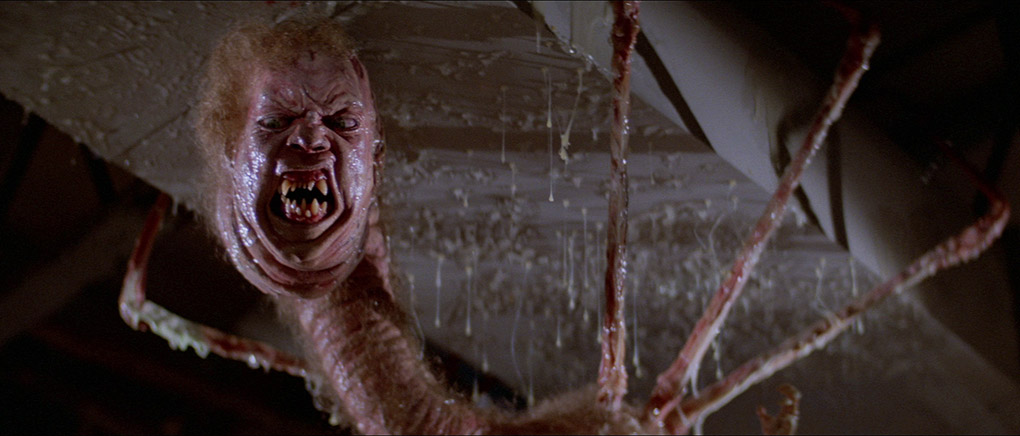
To understand this reaction, at least from a modern perspective when The Thing has become an acknowledged genre classic, you need to transport yourself back to 1982 and imagine what it was like to be assaulted by makeup effects of this complexity and magnitude – there was simply nothing you could watch to adequately prepare you for it. Yes, we'd all been astonished by the transformation sequences in An American Werewolf in London and The Howling, but these were single, stand-alone set-pieces that built on the optical metamorphoses of past werewolf movies, a new take on an old trick, you might say. What unfolded in The Thing was more abstract, more surreal and more genuinely nightmarish. And there was a lot of it. There was not one show-stopping makeup effect sequence here, but a whole string of them, and they were simultaneously stomach-churning and jaw-dropping in a manner that we'd simply never witnessed before. I thus left the cinema so stunned by these scenes that just a couple of hours later I genuinely couldn't remember much else about the film. Others had a similar and often more extreme reaction, and from this grew the false but pervasive perception that the film itself was short on substance and was little more than a showcase for nausea-inducing special effects.
What clarified everything for me was the second viewing, and despite my dazed first response, I was genuinely itching to see it again. This time around, I was prepared for the effects and was not sideswiped by them, and was thus in a far better position to appreciate the film for what it always was, a nail-bitingly tense and claustrophobic science fiction horror-thriller with a superb ensemble cast and a palpable sense of otherworldly dread, a work that took the best elements of 50s monster movies and transformed them into something that felt new and innovative.
If, by some chance, you're new to the film, a little plot is in order. It opens on the disconcerting image of two Norwegian scientists chasing across the Antarctic ice in a helicopter and taking pot-shots at a fleeing dog with a rifle and grenades. What, we are asked to ponder, could be going on here? The helicopter lands at an isolated American research station, where the clumsy mishandling of a grenade destroys the aircraft and kills one of its occupants. His companion continues to shoot wildly at the dog, and when a bullet nicks the leg of one of the Americans, camp commander Garry (Donald Moffat) shoots him in the head. It's a seriously smart and waste-free opening, setting up a mystery whose explanation is trapped first behind a language barrier (though if you speak Norwegian, some clear answers are provided here) and then by the eradication of the only people with the knowledge that the Americans need to protect themselves from a threat of which, at this point, they are unaware. The neat thing is that as an audience we are in the exactly same boat, confused by events and unaware of the significance of what has just unfolded. We're soon provided with some teasing pointers. As life in the research station continues on its acrimonious way, Carpenter's talent for blocking, framing and camera movement (not to mention one of the most impressively low-key performances by a canine ever captured on film), we are subtly pushed to suspect that there's definitely something dodgy about that dog.
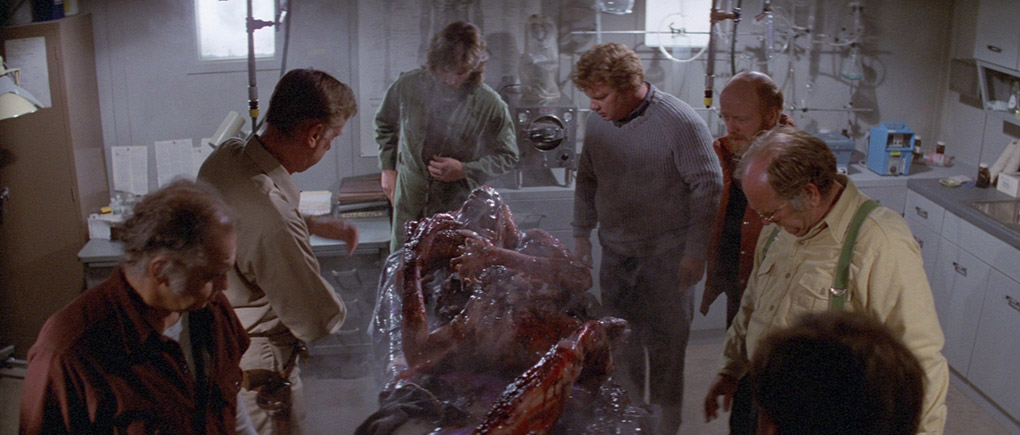
On its release, the film was accused of being effects-driven but The Thing is all about its characters, and having been given 12 of them to keep tabs on by screenwriter Bill Lancaster (son of Burt), Carpenter employs a range of handy shortcuts to ensure that we are able to recognise them as individuals from an early stage, varying their age and appearance, casting each of them with care and giving them personalities and character traits that clearly differentiate them from each other. And while we don't get to know any of them well enough to meaningfully bond with them, it's disarmingly easy to connect with their collective experience, from the isolation of their location and their cabin fever-inspired tetchiness towards one another to the fear and paranoia that that runs rife once the threat is identified.
The tangible air of menace that hangs over the film is first established when the camp's helicopter pilot MacReady (Kurt Russell) and camp doctor Copper (Richard Dysart) fly over to the Norwegian camp and make a series of chilling discoveries, which include a man whose blood from his slit throat and wrists has frozen in mid-flow, a huge block of ice from which something appears to have escaped or been removed, and the burned remains of a humanoid creature with two faces and distorted limbs, which an autopsy back at the American camp reveals has regular human organs. By this point we know something is up with the dog, which is still walking freely around the camp, but when dog-handler Clark (Richard Masur) puts it in a pen with the camp's other dogs, the research crew are starkly introduced to the nature of the threat they are facing.
Look, if you've somehow never seen The Thing, then stop reading this now and hop forward to the final paragraph, as much of what makes this such a dynamite horror-thriller is down to not being able to predict what will happen next. It's a film I'd definitely go into cold if you possibly can, and there are going to be a number of spoilers ahead. For the rest of you, let's talk game-changing makeup effects.
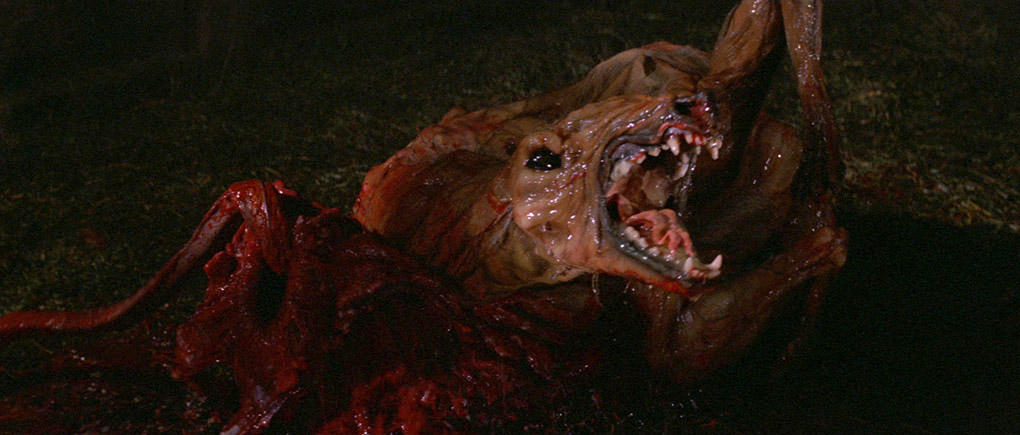
The dog pen sequence is the first major effects set-piece in the film, and while it does indeed showcase the extraordinary talent and vision of effects wizard Rob Bottin and his makeup effects team, every gruesome moment and horrible visual here is fully justified in how it impacts on the characters and the plot development. This needs to go beyond the pale, to show us something that neither we nor the research team have ever seen before, a transformation grotesque enough to stop even grown men in their tracks and horrifying enough not just for us to fear its reappearance, but also to pose a threat so unprecedented and potentially lethal that – as it was with Alien – the question of how it can be destroyed is not one that the characters or we can easily answer. We need to see just what this creature can do and to understand that it can strip down, absorb and imitate other lifeforms, which is confirmed during the autopsy that is performed on the half-transformed creature that immediately follows. Even as we are being startled we are being informed, fed information designed to keep us on edge from this moment onwards and suspecting anyone and everyone of being a potential doppelganger.
Having said that, it's in one of the quietest and most retrospectively low-tech scenes that the scale of the threat is chillingly established, as older scientist Blair (Wilford Brimley) runs a computer simulation to determine how quickly the whole world could be infected should the creature make its way to a populated area. Quite how it would achieve this is suggested in a mid-film dialogue exchange, then later confirmed in one of the most celebrated scenes, where a hot wire is used to test the blood of each of the surviving team members. This not only delivers the best jump-scare in the film, it worryingly suggests that every living cell of this creature has the ability to act independently and infect and ultimately overtake a human or animal host.
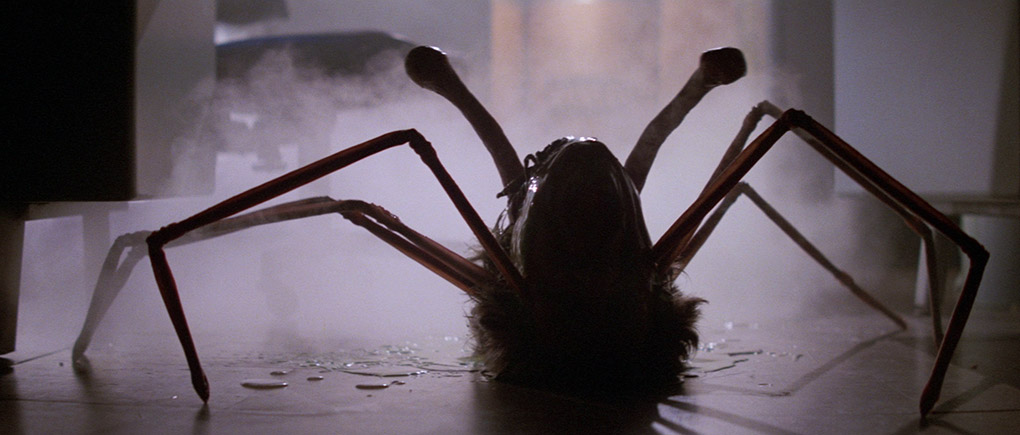
If the film does have a showpiece scene, then it's when Copper attempts to revive a fallen colleague, an extraordinary horror set-piece in which a chest mutates into a sharp-toothed mouth, arms are severed at the elbow, and a head detaches itself from a body by stretching and tearing the neck, then pulls itself under a table and grows legs and eyes, transforming itself into a giant spider and prompting the now famous response from a disbelieving Palmer (David Clennon), "You've got to be fucking kidding!" It's a rare moment of humour in what is otherwise a surprisingly bleak and downbeat film, the sort of neatly-timed tension relief that was a key feature of Carpenter's superb second feature, Assault on Precinct 13. There aren't many others, but a personal favourite occurs during the dog pen sequence, when Clark tells the newly arrived and startled MacReady, "I don't know what the hell's in there, but it's weird and pissed off, whatever it is."
There's little I can say in praise of The Thing that hasn't been said a number of times by others, not bad for a film that was critically lambasted on its release and failed to set the box-office alight. In America, at least, this has been partly blamed on the unfortunate timing of its release, opening just two weeks after Steven Spielberg's E.T. the Extra-Terrestrial prompted everyone and their mother to fall in love with the idea of aliens as loveable and benevolent creatures in family-friendly tales in which the heroes are good-hearted children, not justifiably paranoid and desperate men. The Thing, with its dark tone, its hostile alien and its adult horror leanings, was seen as the antithesis of Spielberg's film, but for those of us who found E.T. indigestible (are there are more of us than you might think), it proved the perfect antidote,* harking back to the paranoia-driven, body-snatch science fiction films of the 1950s, but rethinking them for a post-punk generation for whom happy endings and easy answers played like wish-fulfilment cop-outs. And watching it again, especially looking and sounding as lovely as it does here, I was struck more than ever by a number of things that mark this not just as one of the finest works from one of my favourite filmmakers, but also one of the great science fiction-horror movies of the late twentieth century.
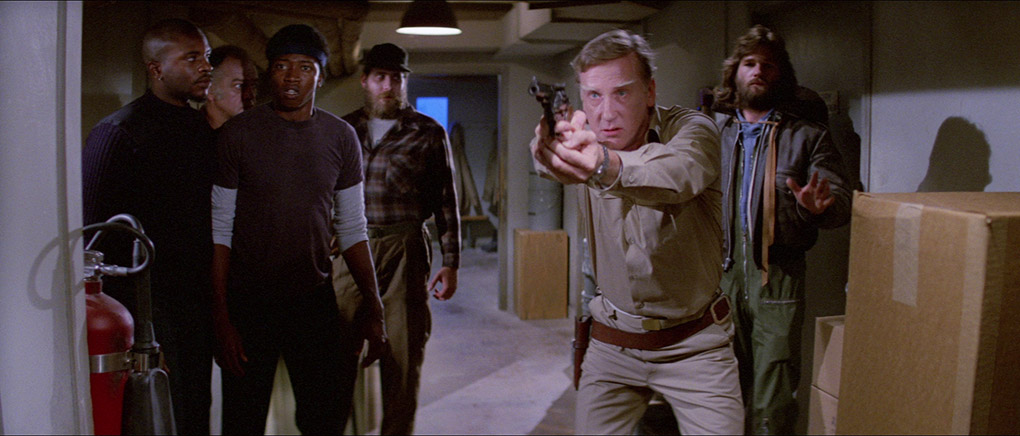
1. The behaviour of the characters makes complete sense within the structure of the story.
It always seemed to me a little unlikely that an Antarctic research station would be staffed by the sort of mismatched individuals who would usually only find themselves in close working proximity because they've been drafted into the army and sent off to war. But I've since learned that screenwriter Bill Lancaster provided solid backstory reasons why each of them would have chosen this posting, and that it's not all down to the appeal of scientific research. Where this really works for the film is that they're not long-standing colleagues with a deep respect for each other, but tetchy, cabin-fever afflicted individuals who get on each other's nerves, and the idea that they could so quickly begin to suspect and ultimately turn on each other thus proves a lot easier to swallow than it would if they had previously been portrayed as close friends.
2. This is a seriously gorgeous looking film.
Every time I come back to The Thing after a break of a couple of years, I find I've forgotten how beautiful it looks. A key aspect of this is John Lloyd superb production design, creating sets that look functional and genuinely lived in and peppering them with the sort of detail that only tends to register subconsciously on early viewings. He makes you believe that you're actually out there in the Antarctic, cut off from civilisation by storms and forced to share space with people who like you about as much as you like them. But the key attraction here is Dean Cundey's glorious scope cinematography and vivid use of light, darkness and colour. He and Carpenter clearly worked in sublime harmony, and it's Cundey's masterful way with light and scope framing that gave Carpenter's early work such a distinctive look. There were plenty of low or even modestly budgeted horror works doing the rounds in the late 70s and early 80s, but none looked as radiant as Halloween or The Fog, and The Thing is up there with Cundey's best work.
3. The soundtrack is superb.
Too often we forget how important the soundtrack is to why a film works as well as it does, and that's certainly true here. Every sound effect, from the cries of terrified dogs and the constant howl of the wind to the wince-inducing scrape of heated copper wire on the base of a petri dish, has been carefully chosen to put you on edge, and the noises emitted by the creature during its transformation have as much to do with why these scenes still have the power to disturb as their show-stopping visuals.
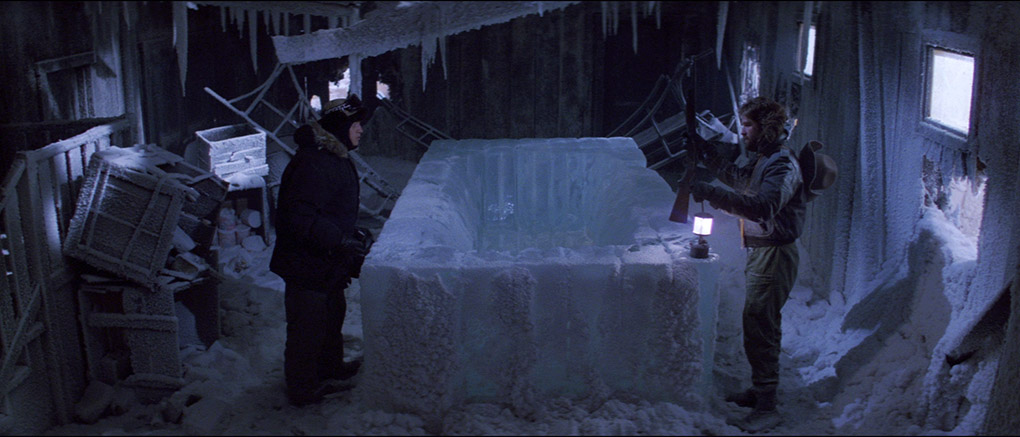
And then we have the music. This may be the first John Carpenter theatrical feature without a self-penned score, but the great Ennio Morricone delivers a pulsing electronic main theme that has Carpenter's signature style written all over it, and also contributes some hauntingly effective orchestral suspense music that always underscores rather than overpowering the action. It's worth noting that working with Morricone was a long-time dream for Carpenter, who walked down the aisle during his wedding to actress Adrienne Barbeau to Jill's Theme from Morricone's score for Sergio Leone's Once Upon a Time in the West.
4. The creature effects are still amazing.
OK, horror fans of my generation do tend to bang on about the tactile nature of physical effects, an argument that is sometimes lost on those raised on the slickness of CGI monsters, which can transform a creature to just about anything without having to cut away to a reaction shot to hide a switch to different stages of the metamorphosis. And yes, there is a degree of artificiality to mechanically operated creatures, which rarely have the fluidity, range of movement and reaction times of their real-world equivalent, which does sometimes highlight the fact that you're watching an effect (though I'd argue this is also true of many CG creations, which are too often pushed beyond the realms of plausibility simply because there are no technical barriers to doing so). Yet despite this, many of the effects here have a disconcertingly organic feel that makes it all too easy to believe – if just for a crucial few seconds – that what you are watching is the real deal. Choice examples include when Blair cuts into the distorted remains recovered from the Norwegian camp and pulls out a succession of authentically gooey organs, or when the creature bursts open and tentacles flail angrily from the cavity with the malevolent purpose of a furiously determined predator. And as with Dean Cundey's photographic compositions and lighting, it is perfectly legitimate to admire and appreciate these effects for their artistry alone, and on that score The Thing offers horrible delights aplenty. It still seems astonishing to me (and others on this disc) that Rob Bottin was just 22 years of age when he created what remains a watermark for special makeup effects.
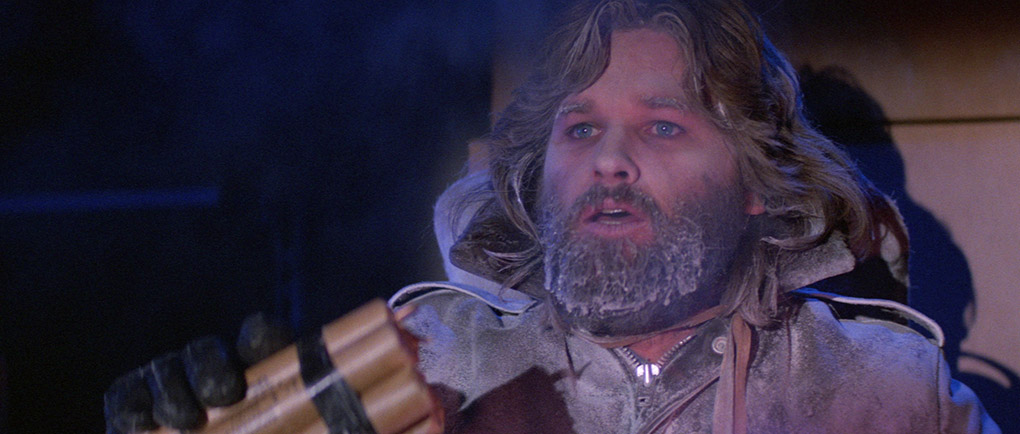
5. The casting and performances are all first-rate.
I remember back at my first viewing having just a tad of apprehension about the lead casting of Kurt Russell, having not initially been the biggest fan of his Clint Eastwood impersonation in Carpenter's Escape From New York (a view that has mellowed somewhat with subsequent viewings, I should note). But he's terrific here as the cynical, heavy-drinking MacReady, emerging as an unforced lead in what is essentially an all-male ensemble piece and convincing completely in the later stages as a desperate man fighting for his very existence (watch his authentic body language after he makes it back inside after nearly freezing to death). Wilford Brimley brings a world-weary authenticity to Blair, particularly in the scene in which he silently watches on as a computer predicts just how fast and far the organism could potentially spread, a calmness that makes the scene when he loses his rag and starts furiously smashing up the station's communication equipment so troubling. Old hand Richard Dysart brings a real air of authority to his delivery as Dr. Copper, and in his first credited feature role, Keith David – who would go on to co-star in Carpenter's They Live – cuts an imposing figure as Childs. Everyone pulls their weight here, and the fact that they all take their roles seriously and play them with such conviction is key to why we so readily buy into their predicament.
6. It's a horror movie, it's a science fiction movie, it's a thriller, it's a mystery...
The Thing genuinely spans genres, organically melding horror with science fiction, but also working as a mystery-thriller, teasing us and its characters with the notion that just about anyone could be a creature that could at any moment turn on its companions. The mix of in-your-face horror, grinding tension and a very real sense of apocalyptic doom also means there's barely a moment when we are able to catch a relaxing breath. And Carpenter has, a little teasingly, left a few questions unanswered for fans to endlessly speculate on, such as just who it was that destroyed the blood samples, when exactly it was that one seemingly unaffected character was taken over by the creature, whether an infected human is initially aware that they are infected, and why it is that a scientific research station needs not one but two flame-throwers.
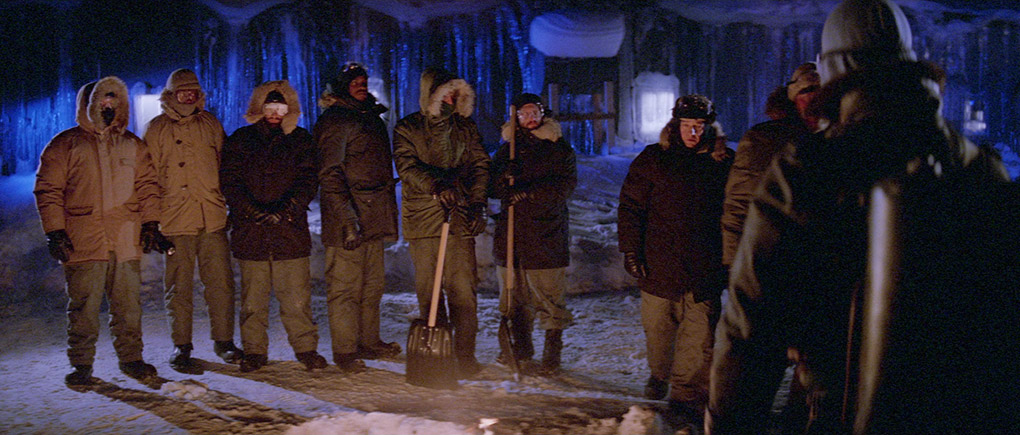
7. The ending.
I'm saying no more, but for me and for so many fans of the film, it's just perfect. Further discussion would be unfair to those who have yet to see the film and ignored my warning above.
8. It all just works.
I'm highlighting individual elements here, but in the end what makes The Thing the sf-horror-thriller-mystery masterpiece that it is lies in the way that they all pull together so sublimely. The cinematography, soundtrack, music, makeup effects and performances are all terrific, but it's the assurance with which Carpenter manages them, ensuring that they complement rather than detract from each other, that makes The Thing such a rewarding experience and has assured that it has stood the test of time with serious aplomb. It's a monster movie par excellence, but in its character detail, depth, intelligence and game-playing with expectations and genre tradition, it's always so much more.
The 2.35:1 1080p transfer here is the result of a new 4K restoration from the original negative carried out by Arrow Films, supervised by James White and approved by John Carpenter and Dean Cundey. Now this is not the first restoration of The Thing, with Universal's 2012 Blu-ray release improving on their earlier Collector's Edition DVD, which itself was something of a flag-waver for qualities of digital discs as a medium for film delivery. Comparing the Universal Blu-ray with the new transfer here, the differences in sharpness and picture detail – which are impressive on both discs – do not exactly hit you in the face, but an up-close examination of identical frame grabs reveals what looks like traces of image enhancement on the Universal disc, evidenced by small halos around the edges of darker objects when positioned against lighter backgrounds that are simply not there on the Arrow transfer, which feels purer as a result. There's also a subtle but telling difference in the contrast and the dynamic range of the picture, as while the Universal transfer boasts consistently punchy contrast, it's toned down a notch on the Arrow transfer, resulting in visibly better shadow detail and a more pleasingly natural and very filmic look. There is some visible noise in the darker areas of a small number of shots, and in a couple the black levels soften a tad, but the gains in the clarity, detail and image richness fully justify this approach. The colour is also more pleasing than on the Universal disc (and it was pretty damned good there), and the shots that really showcase the lighting and colour look utterly gorgeous here. A terrific transfer.**
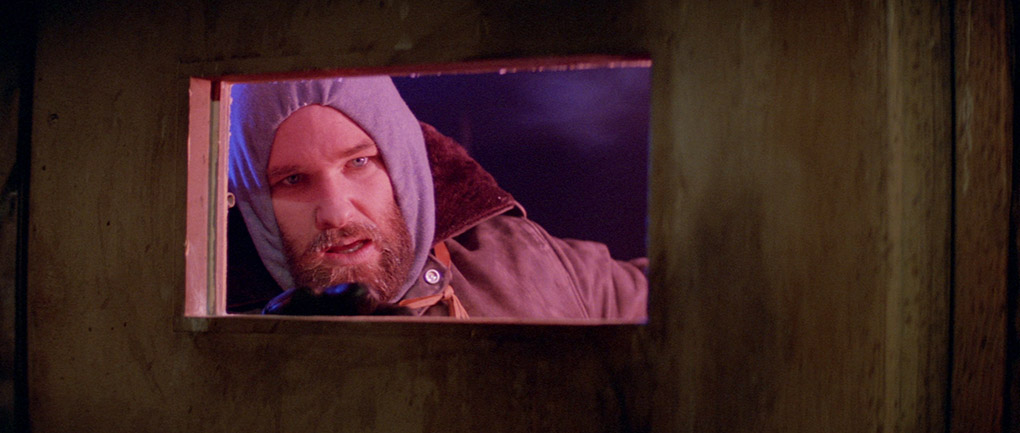
The soundtrack has been sourced from the original 6-track stereo mix, and is available in 2.0 stereo, 4.1 surround and 5.1 surround, all in DTS-HD Master Audio. The stereo track is fine, but if you want to experience the sound at maximum quality then the surround tracks are the only way to go – they are richer, clearer and more inclusive, and boast far better low frequency bass. It would likely take someone with a keen ear and a pristine sound system to start listing the differences between the two surround tracks, as both are first-class, with no trace of damage or background hiss and wonderfully clear reproduction of dialogue, sound effects and music. The howling wind alone will have you reaching for your overcoat.
Optional English subtitles for the deaf and hearing impaired are also available.
Who Goes There? In Search of The Thing (77:47)
An all-new documentary on the development and production not just of Carpenter's film, but also the Howard Hawks/Christian Nyby original, built around video interviews with authors, film historians and some of those involved in the production. It makes for enthralling and educational viewing, and benefits from not simply re-treading ground covered by the main archive documentary included here. The creation of a number of key makeup effects sequences are covered in detail, and I couldn't help but smile when associate producer Larry Franco recalls that his response to the film's hostile critical reception was, "You people can go fuck off!"
1982: One Amazing Summer (27:20)
Another new documentary in which some of the authors and film historians from Who Goes There? look back at a considerable number of successful and memorable (if largely American) films released during the summer and autumn of 1982.
John Carpenter's 'The Thing': Terror Takes Shape (84:00)
A choice import from the 2004 Collector's Edition DVD release, this retrospective documentary on the making of the film is built around interviews with many of those involved in its making, including director John Carpenter, who is conspicuously absent from the new bonus material. Framed 4:3 and in standard definition it may be, but it's the content that makes this such an essential watch, covering the genesis of the project, the planning, the filming, the effects, the release and a whole lot more. Once you've seen the film, I'd make this your first stop.
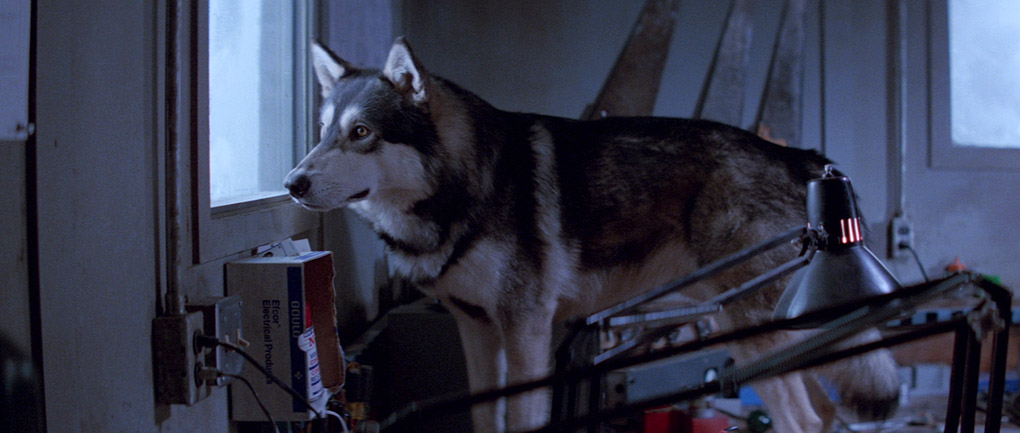
NoThing Left Unsaid: Texas Frightmare Panel (55:08)
A recording of a panel discussion on The Thing held at the Texas Frightmare Weekend in May 2017, hosted by Ryan Turek and featuring cinematographer Dean Cundey and actors Thomas G. Waites (who plays Windows), Keith David (Chiles) and A. Wilford Brimley (Blair). This is far more entertaining than I was expecting, being littered with amusing anecdotes about the shoot, some of which really are laugh-out-loud funny. Cundey is a delight, but even he is outdone by Brimley, whose deadpan and occasionally jet-black humour intermittently has his companions in stitches. When Waites pays tribute to his late co-stars Charles Hallahan and Richard Dysart, for example, and adds, "I really wish they could be here," Brimley responds in a heartbeat, "So do they! But they're dead!" Later, when commenting on why you should never take notice of critics, he says, "Critics shut down a play, overnight, that had a song in it called All the Things You Are. But they leave Les Miserables playing for forty fucking years. That's the most aptly named show…" Great stuff.
The Thing: 27,000 Hours (6:01)
A short film by Sean Hogan, made as part of a series of John Carpenter tribute shorts for the 2011 London FrightFest, that recreates the blood test scene from Carpenter's film on a micro-budget, but with an interesting twist. You can also play this with a commentary by director Sean Hogan, plus Dan Martin and Sam Ashurst from the Arrow Films and Video podcast, who discuss the inception of the project, the actors and the location – the running time doesn't leave much opportunity for much else.
A section titled Fans of The Thing has three separate entries.
Outpost #31 – History and Impact of the Fans (15:42)
Todd Cameron, the founder and editor of The Thing fan site Outpost #31, outlines the origins of and future plans for the site and recalls his trip to the Canadian location where the research station set was constructed. Here, he and his fellow enthusiast Steve Crawford discovered a number of artefacts from the shoot, including a rotor blade from the demolished helicopter, which they wrapped up and stuck stamps on to send home by post. Cool. He's already planning a 40th Anniversary trip, which anyone who's interested in going on is cheerfully invited to join. Speaking with my cameraman's hat on, some of the indoor videography (or should that be post-production grading) is distractingly dark.
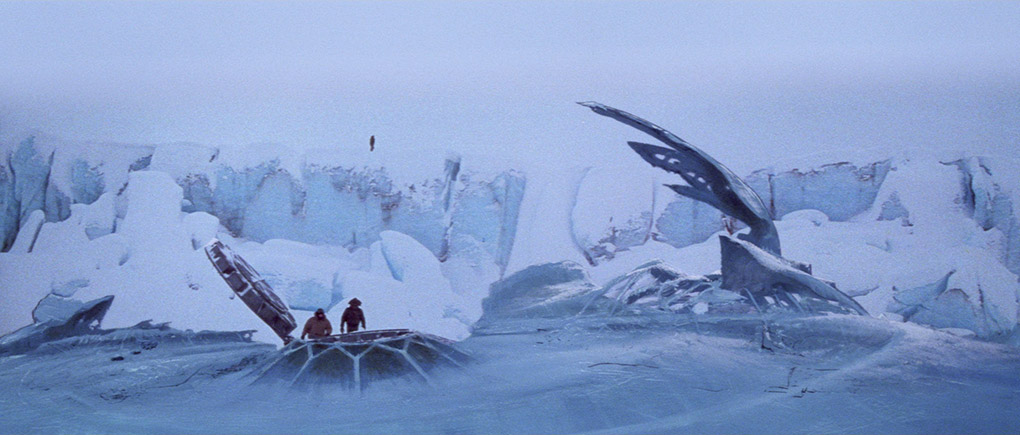
"We've Found Something in the Ice" – A Fan's Journey (5:38)
British fan of The Thing Peter Abbott recalls following in the footsteps of Todd Cameron and making the trip to Canada with his fiancée, where he found the rear rotor blade of the wrecked helicopter, which was just small enough to wedge into his suitcase. He even got John Carpenter to sign it at a convention. As you'd expect, the story is illustrated with photos of the trip.
The Thing Tribute Artwork by Danny Wagner
A small gallery of Danny Wagner's own photos of his paintings and sculptures inspired by The Thing.
Production Archive
This section has nine entries, all of which are sourced from the earlier special edition DVD release and are thus in standard definition.
Production Background Archive
A textual outline of how the film came to be, spread over the course of 30 pages and in very large type, illustrated with a couple of photos and extracts from the script.
Cast Production Photographs
Photos of the main cast, many at what looks like frame grab quality.
Production Art and Storyboards
A fascinating collection of concept artwork with large textual introductions, a couple of photos and some storyboard frames. Such a shame this is not in HD.
Location Design
Photos of the location scouting trip and, more interestingly, the construction of the research station buildings.
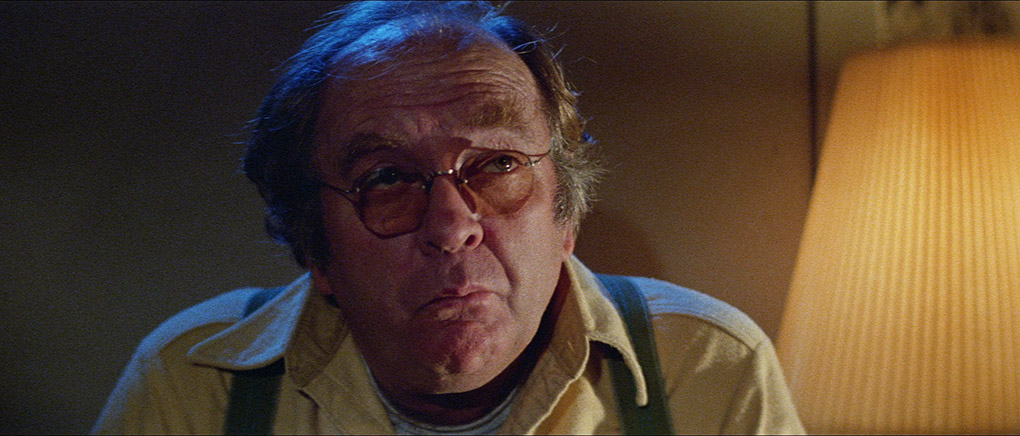
Production Archives
A selection of behind-the-scenes photos and production stills, some excellent storyboard and concept art, and a couple of photos of a mechanical dog.
The Saucer (2:22)
A breakdown of the photographic passes of the opening effects shot of the alien ship approaching earth, plus footage of a number of the matte shots. These also feature in the archive documentary.
The Blairmonster (1:00)
A gallery of production artwork and behind-the-scenes photos of the climactic confrontation with the creature, plus the option to watch the sequence, complete with effects shots that didn't make the final cut.
Outtakes (4:08)
A number of brief deleted and extended scenes, framed 4:3 and mastered from what looks like a standard definition source. One of them would have revealed key information considerably earlier than it now (more effectively) becomes clear in the film.
Post Production
Photos of John Carpenter working with composer Ennio Morricone, plus shots of the Hollywood Pacific Theatre premiere hosted by Elvira, some advertising material (less than I was expecting), and the cover of Alan Dean Foster's novelisation. He was a busy lad around this time.
Trailer (1:58)
A grubby looking trailer, cropped to 4:3 but still tantalising.
Audio Commentary with John Carpenter and Kurt Russell
Carried over from the special edition DVD, this hugely enjoyable commentary with Carpenter and Russell, who are clearly good friends who enjoy working with each other, is a consistently entertaining mix of technical information, memories of the shoot and light-hearted anecdotes. Both have praise aplenty for the work of their collaborators, including Dean Cundey's lighting and the acting skills of the dog. Interesting to hear that audiences were more freaked out by the low-tech finger-cutting effect than the more elaborate creature effects. This was always one of the real highlights of the earlier DVD and is still such fun to listen to.
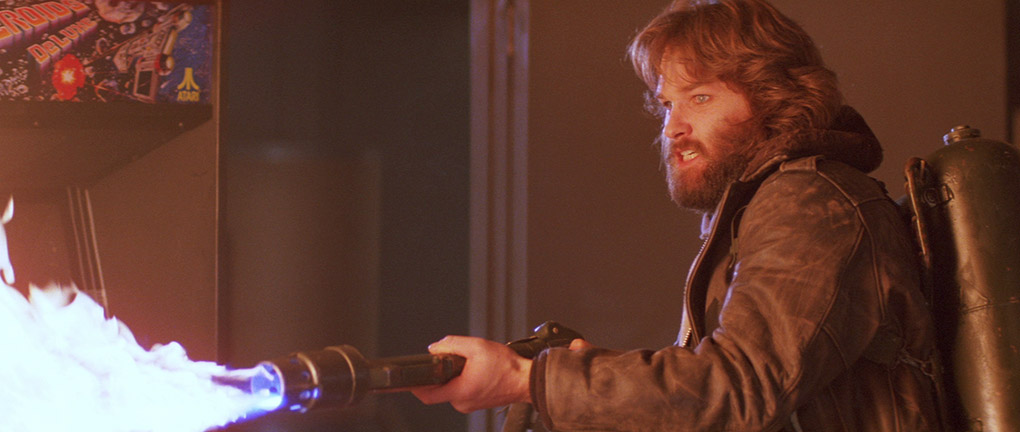
Audio Commentary with Mike White, Patrick Bromley and El Goro
A new audio commentary by Mike White from The Projection Booth podcast, Patrick Bromley from the At This Movie podcast and El Goro from the Talk Without Rhythm podcast. All three are serious The Thing enthusiasts and are well versed in its background and trivia, though how new any of this will be to you will depend on which order you tackle the special features – this is listed last on the menu, and by the time I got to it I'd heard most of what they had to tell me elsewhere. It's a good-natured, fan-boy appreciation of the film nonetheless, and does have its moments, with interesting detail drawn from what sounds like an annotated copy of the original screenplay, some thoughtful comments on the 2011 'premake', and a solid case made for the longevity of the effects. I presume this is a generational thing, but I was really surprised that none of them had heard the word 'bwana' before reading it in Bill Lancaster's screenplay.
Booklet
A handsomely produced booklet whose paper alone has a real ring of quality, which also extends to the content, even if the small white-on-black type gave my ageing eyes a bit of a workout. It kicks off with an essay by Violet Lucca, which offers an intriguing analysis of some key aspects of the film, including its subtextual reading as an AIDS metaphor. The meat of the booklet, however, consists of a detailed, spirited and example-peppered defence of the film by Kevin Alexander Boon, which includes several choice extracts from the original screenplay. Also included are credits, stills, and notes on the restoration.
Included also in this Limited Edition release is a fold-out, double-sided 51x40cm reproduction of two of the original posters and a collection of 8 postcards. These are also double-sided, so you can't send them to anyone. Then again, why would you want to?
Given the quality of the transfers and special features on the earlier Universal Blu-ray and DVD releases, I genuinely wondered how Arrow were going to put their distinctive stamp on this one, but they've done it, and how. A gorgeous transfer, enough high-quality extras to make you over a week late with your review, and the sort of packaging that continues to make collector's edition Blu-rays objects of desire for devotees. A superb release that comes highly recommended.
|